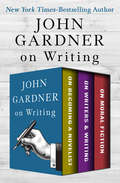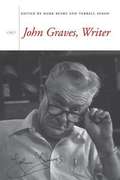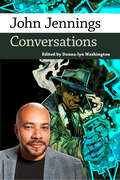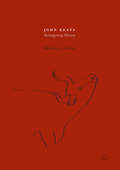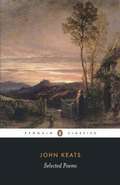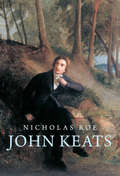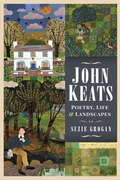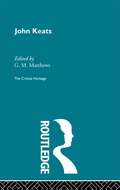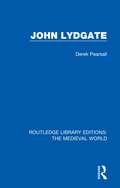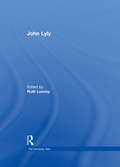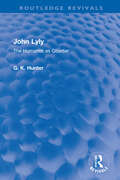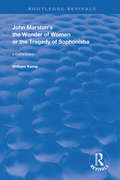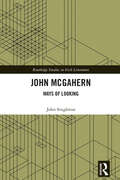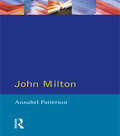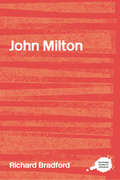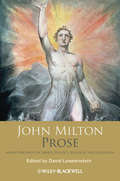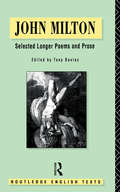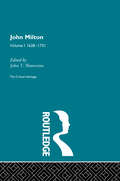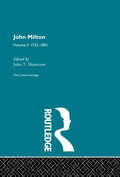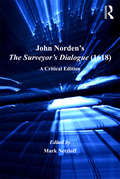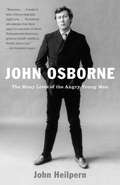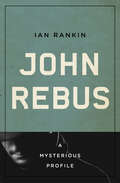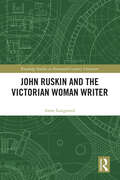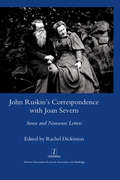- Table View
- List View
John Gardner on Writing: On Becoming a Novelist, On Writers & Writing, and On Moral Fiction
by John GardnerThree books in one volume: Advice and reflections on modern fiction from &“one of the greatest creative writing teachers we&’ve ever had&” (Frederick Busch). In On Becoming a Novelist, John Gardner advises the aspiring fiction author on such topics as the value of creative writing workshops, the developmental stages of literary growth, and the inevitable experience of writer&’s block. Drawn from his two decades of experience in creative writing, Gardner balances his compassion for his students with his knowledge of the publishing industry, and truthfully relates his experiences of the hardships that lie ahead for aspiring authors. In On Writers & Writing, acclaimed novelist John Gardner discusses the craft of fiction writing, taking to task some of his best-known contemporaries in the process. Gardner criticizes some for writing disingenuous fiction, and commends others who produce literature that acts as a life-affirming force. He offers insights into and exacting critiques on such writers as Vladimir Nabokov, John Updike, Saul Bellow, and John Cheever, while addressing his personal influences and delivering broad-ranging observations on literary culture. And in On Moral Fiction, John Gardner&’s thesis is simple: &“True art is by its nature moral.&” Since the book&’s first publication, the passion behind Gardner&’s assertion has both provoked and inspired readers. In examining the work of his peers, Gardner analyzes what has gone wrong, in his view, in modern art and literature, and how shortcomings in artistic criticism have contributed to the problem. He develops his argument by showing how artists and critics can reintroduce morality and substance to their work to improve society and cultivate our morality.
John Graves, Writer
by Mark BusbyRenowned for Goodbye to a River, his now-classic meditation on the natural and human history of Texas, as well as for his masterful ability as a prose stylist, John Graves has become the dean of Texas letters for a legion of admiring readers and fellow writers. Yet apart from his own largely autobiographical works, including Hard Scrabble, From a Limestone Ledge, and Myself and Strangers, surprisingly little has been written about Graves's life or his work. John Graves, Writer seeks to fill that gap with interviews, appreciations, and critical essays that offer many new insights into the man himself, as well as the themes and concerns that animate his writing. The volume opens with the transcript of a revealing, often humorous symposium session in which Graves responds to comments and stories from his old friend Sam Hynes, his former student and contemporary art critic Dave Hickey, and co-editor Mark Busby. Following this is a more formal interview of Graves by Dave Hamrick, who draws the author out on issues relating to each of his major works. John Graves's friends Bill Wittliff, Rick Bass, Bill Broyles, John R. Erickson, Bill Harvey, and James Ward Lee speak to the powerful influence that Graves has had on fellow writers. In addition to these personal observations, nine scholars analyze essential aspects of Graves's work. These include the place of Goodbye to a River within environmental literature and how its writing was a rite of passage for its author; Graves as a prose stylist and a literary, rather than polemical, writer; the ways in which Graves's major works present different aspects of a single narrative about our relationship to the land; the question of gender in Graves's work; and Graves's sometimes contentious relationship with Texas Monthly magazine. Mark Busby introduces the volume with a critical overview of Graves's life and work, and Don Graham concludes it with a discussion of Graves's reception and literary reputation. A bibliography of works by and about Graves rounds out the book. John Graves, Writer confirms Graves's stature not only within Texas letters, but also within American environmental writing, where Graves deserves to be more widely known.
John Jennings: Conversations (Conversations with Comic Artists Series)
by Donna-Lyn WashingtonJohn Jennings (b. 1970) is perhaps best known for his collaboration with Damian Duffy on the New York Times bestseller and Eisner Award–winning graphic novel adaptation of Octavia Butler’s Kindred. However, Jennings is also a graphic designer and comic book scholar who, throughout his career, has conducted several interviews that shed light on the importance of Black Speculative narratives. The most enlightening of his interviews are brought together in John Jennings: Conversations.As a collective these interviews explore folklore, systemic racism, his Mississippi roots, and the phrase Jennings cocreated, the Ethnogothic. Jennings discusses the necessity for black heroes, not just for the sake of diversity, but for inclusiveness, touching on the conventions he has cofounded, such as the Schomburg Center’s Black Comic Book Festival in Harlem. He addresses the struggle to be financially compensated for work, and he speaks at length about how being a professor informs his craft where he continues to examine black stereotypes in popular culture with courses of his own design. As a group the interviews in John Jennings: Conversations give a picture of a black man forging a way where comic books have afforded him a means to carve out an important space for people of color.
John Keats
by William A. UlmerThis book considers Keats's major poems as exercises in Romantic historicism. The poetry's rich allusiveness represents Keats's effort to reclaim the British canon for Cockney revisionism, and reveals Keats characteristically invoking the past to define his contemporary cultural politics. The book begins by discussing Keats's Cockney traditionalism in its Regency context and then proceeds through the poet's career in chronological order. There are chapters on history and vocation in the poet's first volume, the failed idealism of 'Endymion', gender and audience in the Medieval Romances, the 'Ode on a Grecian Urn' in historical context, secularism and consolation in the other great Odes, and then the two 'Hyperion' fragments, in which history ramifies beyond poetic method to become the explicit subject of inquiry. The result is a stimulating reassessment of Keats's intellectual development and most admired poems.
John Keats Selected Poems
by John BarnardOver the course of his short life, John Keats (1795-1821) honed a raw talent into a brilliant poetic maturity. By the end of his brief career, he had written poems of such beauty, imagination and generosity of spirit, that he had - unwittingly - fulfilled his wish that he should 'be among the English poets after my death'. This wide-ranging selection of Keats's poetry contains youthful verse, such as his earliest known poem 'Imitation of Spenser'; poems from his celebrated collection of 1820 - including 'Lamia', 'Isabella', 'The Eve of St Agnes', 'Ode to a Nightingale' and 'Hyperion' - and later celebrated works such as 'La Belle Dame sans Merci'. Also included are many poems considered by Keats to be lesser work, but which illustrate his more earthy, playful side and superb ear for everyday language.
John Keats: A New Life
by Nicholas RoeThis landmark biography of celebrated Romantic poet John Keats explodes entrenched conceptions of him as a delicate, overly sensitive, tragic figure. Instead, Nicholas Roe reveals the real flesh-and-blood poet: a passionate man driven by ambition but prey to doubt, suspicion, and jealousy; sure of his vocation while bitterly resentful of the obstacles that blighted his career; devoured by sexual desire and frustration; and in thrall to alcohol and opium. Through unparalleled original research, Roe arrives at a fascinating reassessment of Keats's entire life, from his early years at Keats's Livery Stables through his harrowing battle with tuberculosis and death at age 25. Zeroing in on crucial turning points, Roe finds in the locations of Keats's poems new keys to the nature of his imaginative quest. Roe is the first biographer to provide a full and fresh account of Keats's childhood in the City of London and how it shaped the would-be poet. The mysterious early death of Keats's father, his mother's too-swift remarriage, living in the shadow of the notorious madhouse Bedlam—all these affected Keats far more than has been previously understood. The author also sheds light on Keats's doomed passion for Fanny Brawne, his circle of brilliant friends, hitherto unknown City relatives, and much more. Filled with revelations and daring to ask new questions, this book now stands as the definitive volume on one of the most beloved poets of the English language.
John Keats: Poetry, Life & Landscapes
by Suzie Grogan“This is a celebratory meld of memoir, biography and travelogue, intensely personal and all the better for it.” —Eleanor Fitzsimons, author of Wilde’s WomenJohn Keats is one of Britain’s best-known and most-loved poets. Despite dying in Rome in 1821, at the age of just twenty-five, his poems continue to inspire generations who reinterpret and reinvent the ways in which we consume his work.Apart from his long association with Hampstead, North London, he has not previously been known as a poet of ‘place’ in the way we associate Wordsworth with the Lake District, for example, and for many years readers considered Keats’s work remote from political and social context. Yet Keats was acutely aware of and influenced by his surroundings: Hampstead; Guy’s Hospital in London where he trained as a doctor; Teignmouth where he nursed his brother Tom; a walking tour of the Lake District and Scotland; the Isle of Wight; the area around Chichester and in Winchester, where his last great ode, “To Autumn,” was composed.Suzie Grogan takes the reader on a journey through Keats’s life and landscapes, introducing us to his best and most influential work. Utilizing primary sources such as Keats’s letters to friends and family and the very latest biographical and academic work, it offers an accessible way to see Keats through the lens of the places he visited and aims to spark a lasting interest in the real Keats—the poet and the man.“Warm and worthwhile observations on how places as varied as the Lake District and the Isle of Wight shaped Keats’s verse.” —Camden New Journal
John Keats: The Critical Heritage
by B. C. SouthamThe Critical Heritage gathers together a large body of critical sources on major figures in literature. Each volume presents contemporary responses to a writer's work, enabling students and researchers to read for themselves, for example, comments on early performances of Shakespeare's plays, or reactions to the first publication of Jane Austen's novels. The carefully selected sources range from landmark essays in the history of criticism to journalism and contemporary opinion, and little published documentary material such as letters and diaries. Significant pieces of criticism from later periods are also included, in order to demonstrate the fluctuations in an author's reputation. Each volume contains an introduction to the writer's published works, a selected bibliography, and an index of works, authors and subjects. The Collected Critical Heritage set will be available as a set of 68 volumes and the series will also be available in mini sets selected by period (in slipcase boxes) and as individual volumes.y
John Lydgate: A Bio-bibliography (Routledge Library Editions: The Medieval World #38)
by Derek PearsallOriginally published in 1970, John Lydgate sets out to restore a sense of perspective to the work of Lydgate, not by attributing a spurious modernity as a precursor of the Renaissance, but by accepting the fact that he is fundamentally medieval. The book analyses Lydgate’s background in literary tradition and compares this with Chaucer’s work. The book looks at Lydgate as a professional craftsman and examines how his work adapted to the demands and occasions of his age. Without over-valuing the poetry, this approach makes it possible to discriminate with increased objectivity between the more and less worthwhile and to distinguish the unexpectedly large number of poems in which craftsman-like competence rises to rhetorical artistry of a high order. In accepting Lydgate as the epitome of his age, the book also provides a diagram of the medieval poetic mind in its basic form and suggests the usefulness of Lydgate as a source book for the understanding of medieval literature.
John Lyly (The University Wits)
by Ruth LunneyJohn Lyly is the first collection of essays dedicated solely to the work of this University Wit, celebrity prose writer, and playwright to the court of Elizabeth. Lyly's energy and wit inspired his contemporaries to follow new directions in prose fiction and stage comedy, and his writings still illuminate sixteenth-century culture for the modern reader. The twenty-four essays in this selection include some older classics, but most date from 1990 onwards and reflect current critical concerns with politics and sexuality, class and audience. Both Euphues books and the eight plays receive some detailed attention. The essays are grouped into four sections: Lessons in Wit, Courting the Queen, Playing with Desire, and Performing Lyly. A biographical summary and critical survey are provided in the introduction; other voices and insights are alluded to in the notes and listed in the wide-ranging bibliography.
John Lyly: The Humanist as Courtier (Routledge Revivals)
by G K HunterFirst published in 1962, John Lyly marks a shift from the traditional focus on John Lyly as the originator of the strange stylistic craze called Euphuism, and as the dramatist from whose plays Shakespeare deigned to borrow some of his earliest and least attractive comic devices to an author whose works are excellent in themselves. Critics have suggested that an independent reading of Euphues, and more especially of the plays, reveals an attractive delicacy of wit and a refined power of linguistic filigree quite independent of his influence on others or his capacity to illustrate the curious tastes of our forefathers. The eight plays – his most mature artistic achievements – are analysed in detail to bring out their relation to the tradition of court drama. A final chapter compares Lyly and Shakespeare in an attempt to show in operation the different traditions which the book has discussed. This book will appeal to students of English literature, drama and literary history.
John Marston's The Wonder of Women or The Tragedy of Sophonisba: A Critical Edition (Routledge Revivals)
by William KempOriginally published in 1979, this volume includes the full text of James Marston's The Wonder of Women, alongside critical and textual notes. Previously to this volume, Sophonisba had appeared in print five times, once independently and four times in collections of Marston's plays; the first edition is a quarto printed in 1606 by John Windet.
John McGahern: Ways of Looking (Routledge Studies in Irish Literature)
by John SingletonJohn McGahern (1934–2006) believed that fiction could act as a window on the world. Such windows, however, frame our fields of vision, alter and shape our perspectives. Far from being static, the artist’s perspective must continually evolve. This book provides a literary analysis of John McGahern’s artistic and poetic vision – his ‘ways of looking’, examining the shifting focus of this vision: how and why it develops, what effects such developments have on the work’s forms and how these forms evolve, at what times and in response to what stimuli. This volume demonstrates that such developments mirror an analogous social expansion during the latter half of the twentieth century and argues that McGahern’s literary spaces relate to his efforts to realise a more accommodating form to envelop the structureless society. While the number of critical studies on McGahern has increased markedly in recent years, research still tends to fall into the well-established camps of social realism or literary aestheticism. This text aims to explore the common ground between the material context and social worlds of each work and the hermeneutics of a ‘traditional’ literary investigation. It traverses such divides through close readings of McGahern’s work, with attention to the topopoetical production of images of the house, the home and the family unit. The book ultimately shows how attention to McGahern’s literary spaces provides a greater understanding of the aesthetic, vision and form of each novel and allows us to understand those aspects relative to the social, cultural and political undercurrents of the works individually and collectively.
John Milton (Longman Critical Readers)
by Annabel M. PattersonThis collection of selected writings represents the best of recent critical work on Milton. The essays cover all stages of his career, from the early poems through to the later poems of the Restoration period, especially Paradise Lost. Professor Patterson includes British and American critics such as Michael Wilding, Victoria Kahn, James Grantham Turner and Mary Ann Radzinowicz and guides the reader through the varied ways Milton's achievement has been explored and debated by modern criticism.
John Milton (Routledge Guides to Literature)
by Richard BradfordThere is a crying need for an accessible, comprehensive guide to John Milton for the thousands of students who make their way through his poetry every year on literary survey and seventeenth century literature courses. Where many previous guides have dragged their way through Paradise Lost, Richard Bradford brings Milton to life with an overview of his life, contexts, work and the relationship between these, and of the main critical issues surrounding his work.
John Milton Prose: Major Writings on Liberty, Politics, Religion, and Education
by John MiltonRegarded by many as the equal of Shakespeare in poetic imagination and expression, Milton was also a prolific writer of prose, applying his potent genius to major issues of domestic, religious and political liberty. This superbly annotated new publication is the most authoritative single-volume anthology yet of Milton's major prose works. Uses Milton's original language, spelling and punctuation Freshly and extensively annotated Notes provide unrivalled contextual analysis as well as illuminating the wealth of Milton's allusions and references Will appeal to a general readership as well as to scholars across the humanities
John Milton: Selected Longer Poems and Prose (Routledge English Texts)
by John MiltonAn edition of Milton's later work rk includes the text of six books of Paradise Lost, The History of Britain and the whole of Samson Agonistes. Through his introduction, commmentary and full annotations, Tony Davies sets the works in their political and cultural contexts, and discusses such themes as the `heroic'; sexuality and gender; and Milton's interrogation of the meaning of history.
John Milton: The Critical Heritage Volume 1 1628-1731 (Studies In The English Renaissance Ser.)
by John T. ShawcrossFirst published in 1995. Routledge is an imprint of Taylor & Francis, an informa company.
John Milton: The Critical Heritage Volume 2 1732-1801 (Studies In The English Renaissance Ser.)
by John T. ShawcrossThe Critical Heritage gathers together a large body of critical sources on major figures in literature. Each volume presents contemporary responses to a writer's work, enabling students and researchers to read for themselves, for example, comments on early performances of Shakespeare's plays, or reactions to the first publication of Jane Austen's novels.The carefully selected sources range from landmark essays in the history of criticism to journalism and contemporary opinion, and little published documentary material such as letters and diaries. Significant pieces of criticism from later periods are also included, in order to demonstrate the fluctuations in an author's reputation.Each volume contains an introduction to the writer's published works, a selected bibliography, and an index of works, authors and subjects.The Collected Critical Heritage set will be available as a set of 68 volumes and the series will also be available in mini sets selected by period (in slipcase boxes) and as individual volumes.
John Norden's The Surveyor's Dialogue: A Critical Edition (Literary and Scientific Cultures of Early Modernity)
by Mark NetzloffThis edition provides the first complete, modern version of John Norden's The Surveyor's Dialogue. Norden's text, a series of dialogues between a fictional surveyor and several interlocutors”including a tenant farmer, an aristocrat landowner, a manorial officer, and a socially mobile land buyer”is remarkable for its unique commentary on the agrarian roots of English capitalism. In his extensive introduction, Mark Netzloff situates the text in relation to a number of early modern contexts. He discusses the use of dialogue and other literary forms in proto-scientific writing and the role of print in the increasing professionalism of early surveyors. Netzloff also examines the impact of capital formation on agrarian and manorial class relations, discussing topics such as popular protest and revolt, cottagers and the rural poor, regionalism and urbanization, and the transformation of the natural environment through deforestation, enclosure, and the appropriation of commons. Alongside a thorough annotation of technical and historical terms, the edition provides a list of textual variants among early modern versions of the text. This critical edition of The Surveyor's Dialogue constitutes an important contribution to early modern scholarship, and it will be invaluable to scholars from a range of fields, including the history of science, economic and agrarian history, and literary and cultural studies.
John Osborne: The Many Lives of the Angry Young Man
by John HeilpernJohn Osborne, the original Angry Young Man, shocked and transformed British theater in the 1950s with his play Look Back in Anger. This startling biography-the first to draw on the secret notebooks in which he recorded his anguish and depression-reveals the notorious rebel in all his heartrending complexity. Through a working-class childhood and five marriages, Osborne led a tumultuous life. An impossible father, he threw his teenage daughter out of the house and never spoke to her again. His last written words were "I have sinned." Theater critic John Heilpern's detailed portrait, including interviews with Osborne's daughter, scores of friends and enemies, and his alleged male lover, shows us a contradictory genius--an ogre with charm, a radical who hated change, and above all, a defiant individualist.
John Paizs's Crime Wave
by Jonathan BallJohn Paizs's 'Crime Wave' examines the Winnipeg filmmaker's 1985 cult film as an important example of early postmodern cinema and as a significant precursor to subsequent postmodern blockbusters, including the much later Hollywood film Adaptation. Crime Wave's comic plot is simple: aspiring screenwriter Steven Penny, played by Paizs, finds himself able to write only the beginnings and endings of his scripts, but never (as he puts it) "the stuff in-between." Penny is the classic writer suffering from writer's block, but the viewer sees him as the (anti)hero in a film told through stylistic parody of 1940s and 50s B-movies, TV sitcoms, and educational films.In John Paizs's 'Crime Wave,' writer and filmmaker Jonathan Ball offers the first book-length study of this curious Canadian film, which self-consciously establishes itself simultaneously as following, but standing apart from, American cinematic and television conventions. Paizs's own story mirrors that of Steven Penny: both find themselves at once drawn to American culture and wanting to subvert its dominance. Exploring Paizs's postmodern aesthetic and his use of pastiche as a cinematic technique, Ball establishes Crime Wave as an overlooked but important cult classic.
John Rebus: A Mysterious Profile (Mysterious Profiles)
by Ian RankinThe New York Times–bestselling author tells the story behind Inspector Rebus, the hard-edged Edinburgh cop and &“superbly drawn character&” (The Times, London). In this short work, Edgar and Diamond Dagger Award winner Ian Rankin delves into DI John Rebus&’s origins as a character, as well as his own origins as a writer. While author and character share a love of literature and a deep affection for Scotland&’s capital city, they differ in other ways, as Rankin entertainingly testifies, while revealing how this &“compelling figure&” has developed over the course of his long-running series of gritty crime novels (Kirkus Reviews). &“[A] hard-drinking, chain-smoking, terminally melancholic hero . . . trapped in a world where mavericks are an endangered species.&” —Booklist &“Rebus is without doubt one of the funniest among the classical fictional detectives.&” —The Guardian &“With his stubborn insistence on tying up the frayed ends of every knotty clue, and iconoclastic refusal to be a team player . . . Rebus is a bane to his superiors but a blessing to readers.&” —Publishers Weekly
John Ruskin and the Victorian Woman Writer (Routledge Studies in Nineteenth Century Literature)
by Anne LongmuirJohn Ruskin and the Victorian Woman Writer addresses the little-considered personal and literary relationships of John Ruskin and four major Victorian women writers: Elizabeth Barrett Browning, George Eliot, Elizabeth Gaskell, and Christina Rossetti. Drawing on new archival, primary research, the book provides detailed biographical contexts for each of these relationships before considering the interplay of each woman’s writing with Ruskin’s. Focusing on literature, art, economics, and gender, it offers close readings of a selection of each woman’s oeuvre alongside Ruskin’s prose to demonstrate the affinities and the moments of disagreement between Ruskin and these writers. Though primarily aimed at an academic audience, the book will also be of interest to general readers with a developed interest in nineteenth-century culture. It advances readers’ understandings of the complex web of influence that existed between Ruskin and women writers in the 1850s and 1860s, establishing the opportunities that Ruskin’s art theory offered women writers engaged with social questions and the apparent influence of these writers on Ruskin’s own emerging political economy. By analysing women writers’ responses to Ruskin’s work—and his response to theirs—this book complicates and challenges assumptions about Ruskin’s supposedly troubled relationship with women.
John Ruskin's Correspondence with Joan Severn: Sense and Nonsense Letters
by Rachel Dickinson"The great Library Edition of the Works of John Ruskin spans 39 volumes and, over the course of the century, further compilations of his private diaries and letters have appeared: but the most important epistolary relationship of his later years, shared with his Scottish cousin Joan (Agnew Ruskin) Severn, has until now been entirely unpublished. These letters - more than 3,000 of them - have been challenging for Ruskin scholars to draw upon, with their baby-talk, apparent nonsense and unelaborated personal references. Yet they contain important statements of Ruskins opinions on travel, on fashion, on the ideal arts and crafts home, on effective education and other questions: and Ruskin often used his letters to Severn as a substitute for his personal diary. In this important new edition, Dickinson presents an edited, annotated selection of a correspondence which, until now, has been almost inaccessible to scholars of Ruskin and of the Victorian period."
